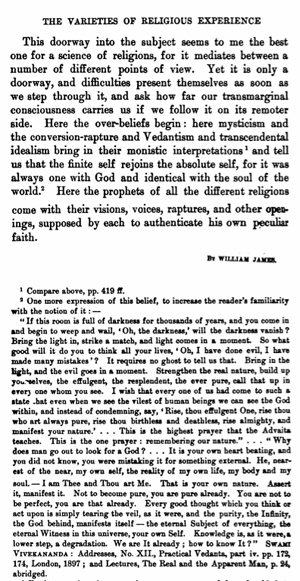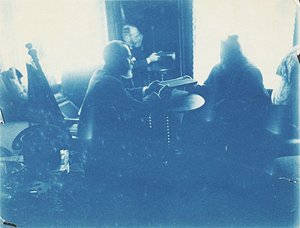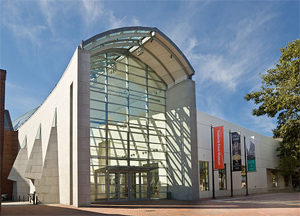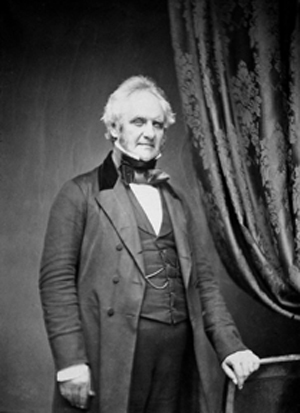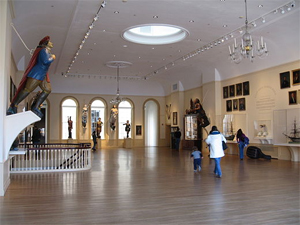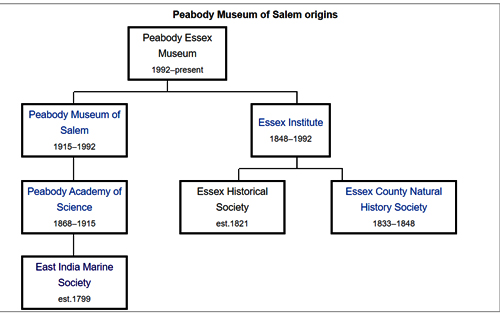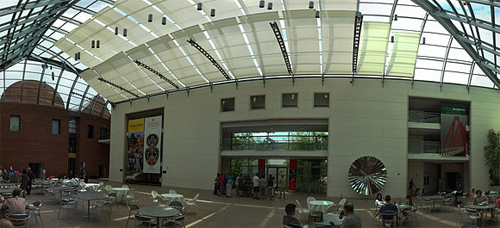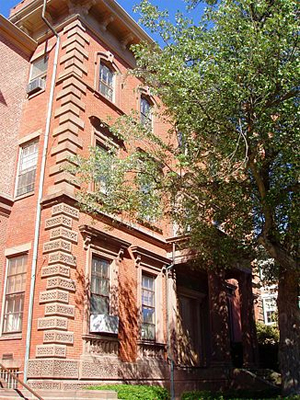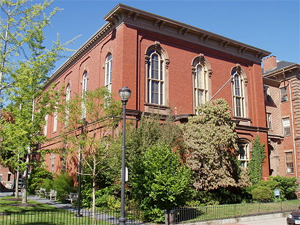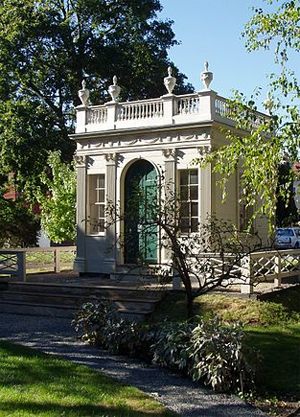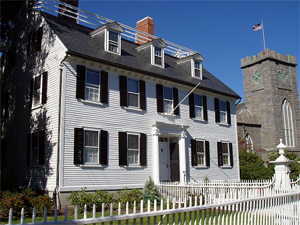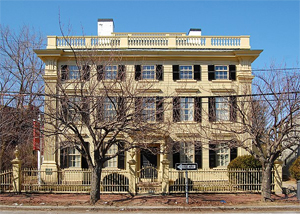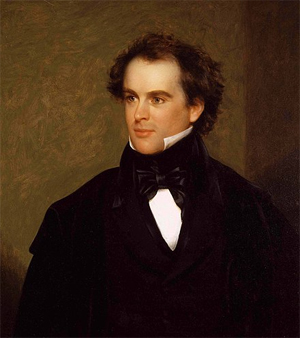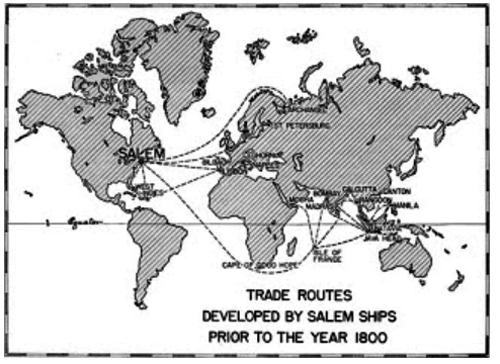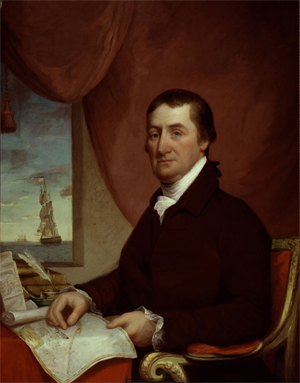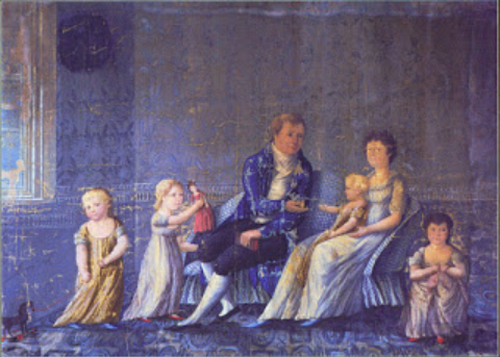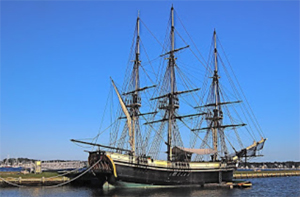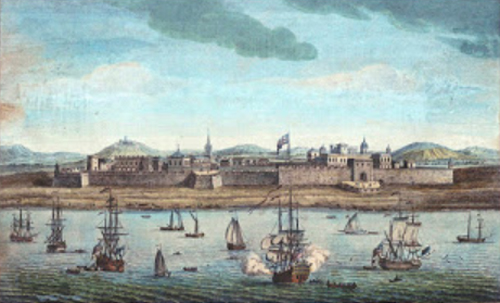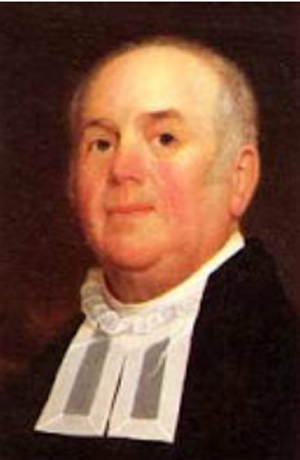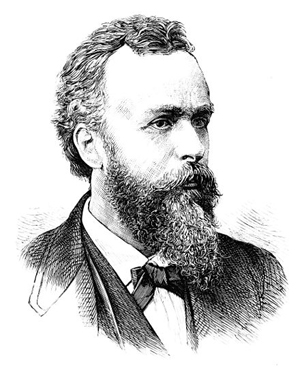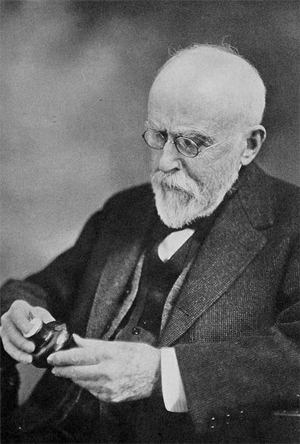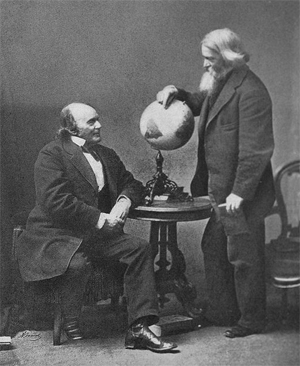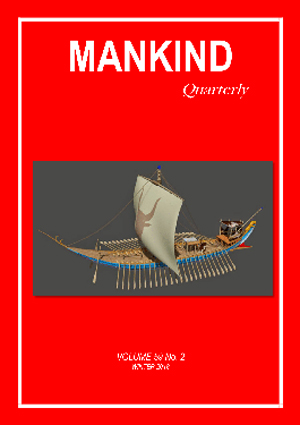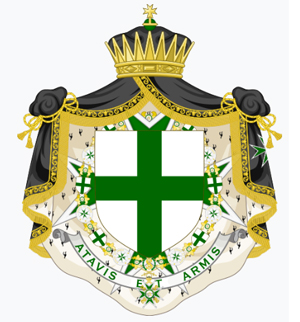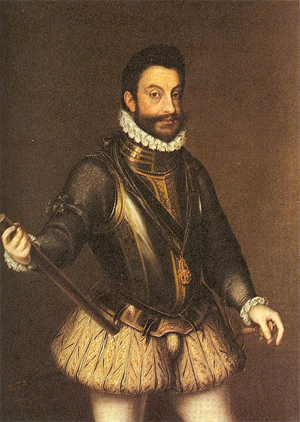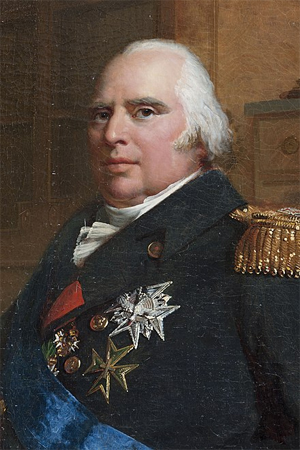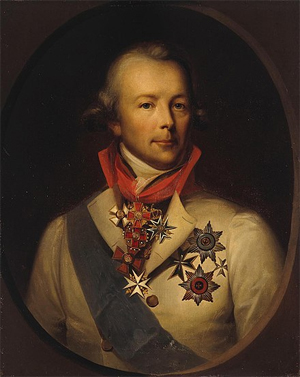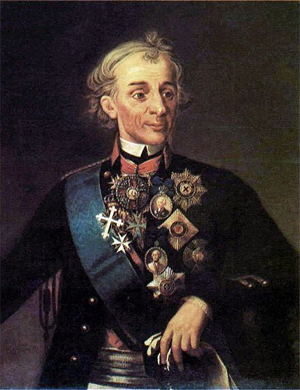William James
by Wikipedia
Accessed: 6/25/20
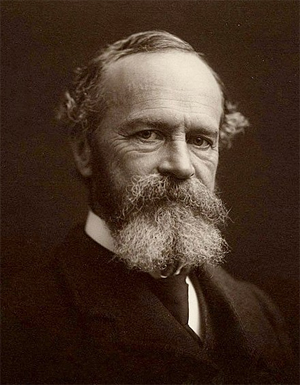
William James, MD
James in 1903
Born: January 11, 1842, New York City, US
Died: August 26, 1910 (aged 68), Tamworth, New Hampshire, US
Nationality: American
Alma mater: Harvard University, MD (1869)[1]
Era: 19th-/20th-century philosophy
Region: Western philosophy
School: Pragmatism functional psychology radical empiricism
Institutions: Harvard University
Notable students: Edwin Holt, Ralph Barton Perry
Main interests: Pragmatism, psychology, philosophy of religion, epistemology, meaning
Notable ideas: Will to believe doctrine; pragmatic theory of truth; radical empiricism; James–Lange theory of emotion; psychologist's fallacy; brain usage theory; soft determinism; dilemma of determinism; stream of consciousness; James' theory of the self; the term multiverse
Influences: Louis Agassiz William Kingdon Clifford[2] David Hartley Hermann Helmholtz David Hume Pierre Janet Jules Lequier Ernst Mach John Stuart Mill Charles Sanders Peirce Charles Bernard Renouvier Bernhard Riemann F. C. S. Schiller Afrikan Spir[3] Emanuel Swedenborg
Influenced: Henri Bergson Jimmy Carter Morris Raphael Cohen John Dewey W. E. B. Du Bois Émile Durkheim Edwin Holt Edmund Husserl C. Wright Mills Gertrude Stein[4] Hilary Putnam Richard Rorty Bertrand Russell George Santayana F. C. S. Schiller Alfred Schütz Alfred North Whitehead Antonio Damasio William Sheldon
William James (January 11, 1842 – August 26, 1910) was an American philosopher and psychologist, and the first educator to offer a psychology course in the United States.[5] James is considered to be a leading thinker of the late nineteenth century, one of the most influential philosophers of the United States, and the "Father of American psychology".[6][7][8]
Along with Charles Sanders Peirce, James established the philosophical school known as pragmatism, and is also cited as one of the founders of functional psychology. A Review of General Psychology analysis, published in 2002, ranked James as the 14th most eminent psychologist of the 20th century.[9] A survey published in American Psychologist in 1991 ranked James's reputation in second place,[10] after Wilhelm Wundt, who is widely regarded as the founder of experimental psychology.[11][12] James also developed the philosophical perspective known as radical empiricism. James's work has influenced philosophers and academics such as Émile Durkheim, W. E. B. Du Bois, Edmund Husserl, Bertrand Russell, Ludwig Wittgenstein, Hilary Putnam, and Richard Rorty.[13]
Born into a wealthy family, James was the son of the Swedenborgian theologian Henry James Sr. and the brother of both the prominent novelist Henry James and the diarist Alice James. James trained as a physician and taught anatomy at Harvard, but never practiced medicine. Instead he pursued his interests in psychology and then philosophy. James wrote widely on many topics, including epistemology, education, metaphysics, psychology, religion, and mysticism. Among his most influential books are The Principles of Psychology, a groundbreaking text in the field of psychology; Essays in Radical Empiricism, an important text in philosophy; and The Varieties of Religious Experience, an investigation of different forms of religious experience, including theories on mind-cure.[14]
Early life
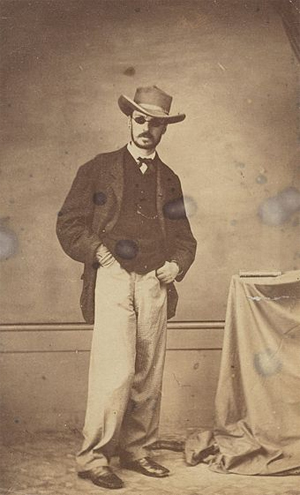
William James in Brazil, 1865
William James was born at the Astor House in New York City on January 11, 1842. He was the son of Henry James Sr., a noted and independently wealthy Swedenborgian theologian well acquainted with the literary and intellectual elites of his day. The intellectual brilliance of the James family milieu and the remarkable epistolary talents of several of its members have made them a subject of continuing interest to historians, biographers, and critics.
William James received an eclectic trans-Atlantic education, developing fluency in both German and French. Education in the James household encouraged cosmopolitanism. The family made two trips to Europe while William James was still a child, setting a pattern that resulted in thirteen more European journeys during his life. His early artistic bent led to an apprenticeship in the studio of William Morris Hunt in Newport, Rhode Island, but he switched in 1861 to scientific studies at the Lawrence Scientific School of Harvard College.
In his early adulthood, James suffered from a variety of physical ailments, including those of the eyes, back, stomach, and skin. He was also tone deaf.[15] He was subject to a variety of psychological symptoms which were diagnosed at the time as neurasthenia, and which included periods of depression during which he contemplated suicide for months on end. Two younger brothers, Garth Wilkinson (Wilky) and Robertson (Bob), fought in the Civil War. The other three siblings (William, Henry, and Alice James) all suffered from periods of invalidism.
He took up medical studies at Harvard Medical School in 1864 (according to his brother Henry James, the author). He took a break in the spring of 1865 to join naturalist Louis Agassiz on a scientific expedition up the Amazon River, but aborted his trip after eight months, as he suffered bouts of severe seasickness and mild smallpox. His studies were interrupted once again due to illness in April 1867. He traveled to Germany in search of a cure and remained there until November 1868; at that time he was 26 years old. During this period, he began to publish; reviews of his works appeared in literary periodicals such as the North American Review.
James finally earned his M.D. degree in June 1869 but he never practiced medicine. What he called his "soul-sickness" would only be resolved in 1872, after an extended period of philosophical searching. He married Alice Gibbens in 1878. In 1882 he joined the Theosophical Society.[16]
James's time in Germany proved intellectually fertile, helping him find that his true interests lay not in medicine but in philosophy and psychology. Later, in 1902 he would write: "I originally studied medicine in order to be a physiologist, but I drifted into psychology and philosophy from a sort of fatality. I never had any philosophic instruction, the first lecture on psychology I ever heard being the first I ever gave".[17]
In 1875–1876, James, Henry Pickering Bowditch (1840–1911), Charles Pickering Putnam (1844–1914), and James Jackson Putnam (1846–1918) founded the Putnam Camp at St. Huberts, Essex County, New York.[18]
Career
James interacted with a wide array of writers and scholars throughout his life, including his godfather Ralph Waldo Emerson, his godson William James Sidis, as well as Charles Sanders Peirce, Bertrand Russell, Josiah Royce, Ernst Mach, John Dewey, Macedonio Fernández, Walter Lippmann, Mark Twain, Horatio Alger, G. Stanley Hall, Henri Bergson, Carl Jung, Jane Addams and Sigmund Freud.
James spent almost all of his academic career at Harvard. He was appointed instructor in physiology for the spring 1873 term, instructor in anatomy and physiology in 1873, assistant professor of psychology in 1876, assistant professor of philosophy in 1881, full professor in 1885, endowed chair in psychology in 1889, return to philosophy in 1897, and emeritus professor of philosophy in 1907.
James studied medicine, physiology, and biology, and began to teach in those subjects, but was drawn to the scientific study of the human mind at a time when psychology was constituting itself as a science. James's acquaintance with the work of figures like Hermann Helmholtz in Germany and Pierre Janet in France facilitated his introduction of courses in scientific psychology at Harvard University. He taught his first experimental psychology course at Harvard in the 1875–1876 academic year.[19]
During his Harvard years, James joined in philosophical discussions and debates with Charles Peirce, Oliver Wendell Holmes, and Chauncey Wright that evolved into a lively group informally known as The Metaphysical Club in 1872. Louis Menand (2001) suggested that this Club provided a foundation for American intellectual thought for decades to come. James joined the Anti-Imperialist League in 1898, in opposition to the United States annexation of the Philippines.
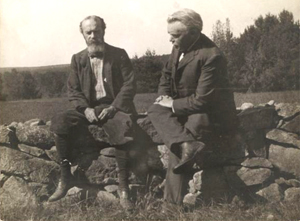
William James and Josiah Royce, near James's country home in Chocorua, New Hampshire in September 1903. James's daughter Peggy took the picture. On hearing the camera click, James cried out: "Royce, you're being photographed! Look out! I say Damn the Absolute!"
Among James's students at Harvard University were luminaries such as Boris Sidis, Theodore Roosevelt, George Santayana, W. E. B. Du Bois, G. Stanley Hall, Ralph Barton Perry, Gertrude Stein, Horace Kallen, Morris Raphael Cohen, Walter Lippmann, Alain Locke, C. I. Lewis, and Mary Whiton Calkins. Antiquarian bookseller Gabriel Wells tutored under him at Harvard in the late 1890s.[20]
Following his January, 1907 retirement from Harvard, James continued to write and lecture, publishing Pragmatism, A Pluralistic Universe, and The Meaning of Truth. James was increasingly afflicted with cardiac pain during his last years. It worsened in 1909 while he worked on a philosophy text (unfinished but posthumously published as Some Problems in Philosophy). He sailed to Europe in the spring of 1910 to take experimental treatments which proved unsuccessful, and returned home on August 18. His heart failed on August 26, 1910, at his home in Chocorua, New Hampshire.[21] He was buried in the family plot in Cambridge Cemetery, Cambridge, Massachusetts.
He was one of the strongest proponents of the school of functionalism in psychology and of pragmatism in philosophy. He was a founder of the American Society for Psychical Research, as well as a champion of alternative approaches to healing. He challenged his professional colleagues not to let a narrow mindset prevent an honest appraisal of those beliefs.
In an empirical study by Haggbloom et al. using six criteria such as citations and recognition, James was found to be the 14th most eminent psychologist of the 20th century.[22]
Family
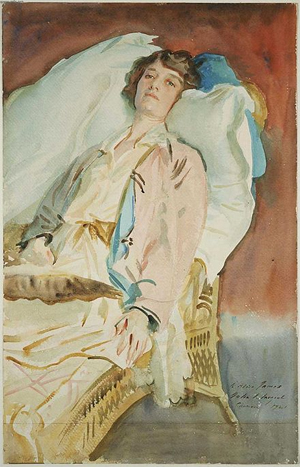
Alice Runnels James (Mrs. William James), John Singer Sargent, 1921
William James was the son of Henry James (Senior) of Albany, and Mary Robertson Walsh. He had four siblings: Henry (the novelist), Garth Wilkinson, Robertson, and Alice.[23] William became engaged to Alice Howe Gibbens on May 10, 1878; they were married on July 10. They had 5 children: Henry (born May 18, 1879), William (June 17, 1882 - 1961), Herman (born 1884, died in infancy), Margaret (born March, 1887) and Alexander (the artist) (born December 22, 1890).
Writings
William James wrote voluminously throughout his life. A non-exhaustive bibliography of his writings, compiled by John McDermott, is 47 pages long.[24]
He gained widespread recognition with his monumental The Principles of Psychology (1890), totaling twelve hundred pages in two volumes, which took twelve years to complete. Psychology: The Briefer Course, was an 1892 abridgement designed as a less rigorous introduction to the field. These works criticized both the English associationist school and the Hegelianism of his day as competing dogmatisms of little explanatory value, and sought to re-conceive the human mind as inherently purposive and selective.
President Jimmy Carter's Moral Equivalent of War Speech, on April 17, 1977, equating the United States' 1970s energy crisis, oil crisis and the changes and sacrifices Carter's proposed plans would require with the "moral equivalent of war," may have borrowed its title, much of its theme and the memorable phrase from James' classic essay "The Moral Equivalent of War" derived from his last speech, delivered at Stanford University in 1906, and published in 1910, in which "James considered one of the classic problems of politics: how to sustain political unity and civic virtue in the absence of war or a credible threat ..." and which "... sounds a rallying cry for service in the interests of the individual and the nation."[25] [26] [27][28]
Epistemology
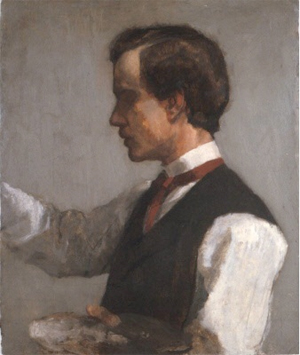
Portrait of William James by John La Farge, circa 1859
James defined true beliefs as those that prove useful to the believer. His pragmatic theory of truth was a synthesis of correspondence theory of truth and coherence theory of truth, with an added dimension. Truth is verifiable to the extent that thoughts and statements correspond with actual things, as well as the extent to which they "hang together," or cohere, as pieces of a puzzle might fit together; these are in turn verified by the observed results of the application of an idea to actual practice.[29][30]
The most ancient parts of truth…also once were plastic. They also were called true for human reasons. They also mediated between still earlier truths and what in those days were novel observations. Purely objective truth, truth in whose establishment the function of giving human satisfaction in marrying previous parts of experience with newer parts played no role whatsoever, is nowhere to be found. The reasons why we call things true is the reason why they are true, for 'to be true' means only to perform this marriage-function.
— "Pragmatism's Conception of Truth," Pragmatism (1907), p. 83.
James held a world view in line with pragmatism, declaring that the value of any truth was utterly dependent upon its use to the person who held it. Additional tenets of James's pragmatism include the view that the world is a mosaic of diverse experiences that can only be properly interpreted and understood through an application of 'radical empiricism.' Radical empiricism, not related to the everyday scientific empiricism, asserts that the world and experience can never be halted for an entirely objective analysis; the mind of the observer and the act of observation affect any empirical approach to truth. The mind, its experiences, and nature are inseparable. James's emphasis on diversity as the default human condition—over and against duality, especially Hegelian dialectical duality—has maintained a strong influence in American culture. James's description of the mind-world connection, which he described in terms of a 'stream of consciousness,' had a direct and significant impact on avant-garde and modernist literature and art, notably in the case of James Joyce.
In "What Pragmatism Means" (1906), James writes that the central point of his own doctrine of truth is, in brief:[31]
Truths emerge from facts, but they dip forward into facts again and add to them; which facts again create or reveal new truth (the word is indifferent) and so on indefinitely. The 'facts' themselves meanwhile are not true. They simply are. Truth is the function of the beliefs that start and terminate among them.
Richard Rorty made the contested claim that James did not mean to give a theory of truth with this statement and that we should not regard it as such. However, other pragmatism scholars such as Susan Haack and Howard Mounce do not share Rorty's instrumentalist interpretation of James.[32]
In The Meaning of Truth (1909), James seems to speak of truth in relativistic terms, in reference to critics of pragmatism: "The critic's trouble…seems to come from his taking the word 'true' irrelatively, whereas the pragmatist always means 'true for him who experiences the workings.'"[33] However, James responded to critics accusing him of relativism, scepticism, or agnosticism, and of believing only in relative truths. To the contrary, he supported an epistemological realism position.[i]
Pragmatism and "cash value"
Pragmatism is a philosophical approach that seeks to both define truth and resolve metaphysical issues. William James demonstrates an application of his method in the form of a simple story:[34][31]
A live squirrel supposed to be clinging on one side of a tree-trunk, while over against the tree’s opposite side a human being was imagined to stand. This human witness tries to get sight of the squirrel by moving rapidly round the tree, but no matter how fast he goes, the squirrel moves as fast in the opposite direction, and always keeps the tree between himself and the man.… The resultant metaphysical problem now is this: Does the man go round the squirrel or not?
James solves the issue by making a distinction between practical meaning. That is, the distinction between meanings of 'round.' Round in the sense that the man occupies the space north, east, south, and west of the squirrel; and round in the sense that the man occupies the space facing the squirrel's belly, back and sides. Depending on what the debaters meant by “going round,” the answer would be clear. From this example James derives the definition of the pragmatic method: to settle metaphysical disputes, one must simply make a distinction of practical consequences between notions, then, the answer is either clear, or the “dispute is idle.”[34] Both James and his colleague, Charles Sanders Peirce, coined the term 'cash value':[35]
When he said that the whole meaning of a (clear) conception consists in the entire set of its practical consequences, he had in mind that a meaningful conception must have some sort of experiential “cash value,” must somehow be capable of being related to some sort of collection of possible empirical observations under specifiable conditions.
A statement's truthfulness is verifiable through its correspondence to reality, and its observable effects of putting the idea to practice. For example, James extends his Pragmatism to the hypothesis of God: “On pragmatic principles, if the hypothesis of God works satisfactorily in the widest sense of the word, it is true.… The problem is to build it out and determine it so that it will combine satisfactorily with all the other working truths."[36] From this, we also know that 'new' truths must also correspond to already existent truths as well.
From the introduction by Bruce Kuklick (1981, p. xiv) to James' Pragmatism:
James went on to apply the pragmatic method to the epistemological problem of truth. He would seek the meaning of 'true' by examining how the idea functioned in our lives. A belief was true, he said, if it worked for all of us, and guided us expeditiously through our semihospitable world. James was anxious to uncover what true beliefs amounted to in human life, what their "cash value" was, and what consequences they led to. A belief was not a mental entity which somehow mysteriously corresponded to an external reality if the belief were true. Beliefs were ways of acting with reference to a precarious environment, and to say they were true was to say they were efficacious in this environment. In this sense the pragmatic theory of truth applied Darwinian ideas in philosophy; it made survival the test of intellectual as well as biological fitness.
James' book of lectures on pragmatism is arguably the most influential book of American philosophy. The lectures inside depict his position on the subject. In his sixth lecture, he begins by defining truth as "agreement with reality."[29] With this, James warns that there will be disagreements between pragmatics and intellectualists over the concepts of "agreement" and "reality", the last reasoning before thoughts settle and become autonomous for us. However, he contrasts this by supporting a more practical interpretation that: a true idea or belief is one that we can blend with our thinking so that it can be justified through experiences.[37]
If theological ideas prove to have a value for concrete life, they will be true, for pragmatism, in the sense of being good for so much. For how much more they are true, will depend entirely on their relations to the other truths that also have to be Acknowledged.
— Pragmatism (1907), p. 29
Whereby the agreement of truths with 'reality' results in useful outcomes, "the 'reality' with which truths must agree has three dimensions:"[37][13]
1. "matters of fact;"
2. "relations of ideas;" and
3. "the entire set of other truths to which we are committed."
According to James' pragmatic approach to belief, knowledge is commonly viewed as a justified and true belief. James will accept a view if its conception of truth is analyzed and justified through interpretation, pragmatically. As a matter of fact, James' whole philosophy is of productive beliefs.
Belief in anything involves conceiving of how it is real, but disbelief is the result when we dismiss something because it contradicts another thing we think of as real. In his "Sentiment of Rationality", saying that crucial beliefs are not known is to doubt their truth, even if it seems possible. James names four "postulates of rationality" as valuable but unknowable: God, immorality, freedom, and moral duty.[37][38]
In contrast, the weak side to pragmatism is that the best justification for a claim is whether it works. However, a claim that does not have outcomes cannot be justified, or unjustified, because it will not make a difference.
"There can be no difference that doesn't make a difference."
— Pragmatism (1907), p. 45
When James moves on to then state that pragmatism's goal is ultimately “to try to interpret each notion by tracing its respective practical consequences,” he does not clarify what he means by “practical consequences.”[39] On the other hand, his friend, colleague, and another key founder in establishing pragmatist beliefs, Charles S. Peirce, dives deeper in defining these consequences. For Peirce, “the consequences we are concerned with are general and intelligible."[40] He further explains this in his 1878 paper “How to Make Ideas Clear,” when he introduces a maxim that allows one to interpret consequences as grades of clarity and conception.[41] Describing how everything is derived from perception, Peirce uses the example of the doctrine of transubstantiation to show exactly how he defines practical consequences. Protestants interpret the bread and wine of the Eucharist is flesh and blood in only a subjective sense, while Catholics would label them as actual meat and blood, even with the physical properties of bread and wine. But to everyone, there can be no knowledge of the wine and bread of the Eucharist unless it is established that either wine and bread possesses certain properties or that anything that is interpreted as the blood and body of Christ is the blood and body of Christ. With this Peirce declares that “our action has exclusive reference to what affects the senses,” and that we can mean nothing by transubstantiation than “what has certain effects, direct or indirect, upon our senses."[42] In this sense, James' pragmatic influencer Peirce establishes that what counts as a practical consequence or effect is what can affect one's senses and what is comprehendible and fathomable in the natural world.
Yet James never “[works] out his understanding of ‘practical consequences’ as fully as Peirce did,” nor does he limit these consequences to the senses like Peirce.[40] It then raises the question: what does it mean to be practical? Whether James means the greatest number of positive consequences (in light of utilitarianism), a consequence that considers other perspectives (like his compromise of the tender and tough ways of thinking),[43] or a completely different take altogether, it is unclear to truly tell what consequence truly fits the pragmatic standard, and what doesn’t. The closest James is able to get in explaining this idea is by telling his audience to weigh the difference it would “practically make to anyone” if one opinion over the other were true, and although he attempts to clarify it, he never specifies nor establishes the method in which one would weigh the difference between one opinion over the other.[39] Thus, the flaw in his argument appears in that it is difficult to fathom how he would determine these practical consequences, which he continually refers to throughout his work, to be measured and/or interpreted.
Will to believe doctrine
Main article: The Will to Believe
In William James' 1896 lecture titled "The Will to Believe", James defends the right to violate the principle of evidentialism in order to justify hypothesis venturing. This idea foresaw 20th century objections to evidentialism and sought to ground justified belief in an unwavering principle that would prove more beneficial. Through his philosophy of pragmatism William James justifies religious beliefs by using the results of his hypothetical venturing as evidence to support the hypothesis' truth. Therefore, this doctrine allows one to assume belief in a god and prove its existence by what the belief brings to one's life.
This was criticized by advocates of skepticism rationality, like Bertrand Russell in Free Thought and Official Propaganda and Alfred Henry Lloyd with The Will to Doubt. Both argued that one must always adhere to fallibilism, recognizing of all human knowledge that "None of our beliefs are quite true; all have at least a penumbra of vagueness and error," and that the only means of progressing ever-closer to the truth is to never assume certainty, but always examine all sides and try to reach a conclusion objectively.
Free will
In his search for truth and assorted principles of psychology, William James developed his two-stage model of free will. In his model, he tries to explain how it is people come to the making of a decision and what factors are involved in it. He firstly defines our basic ability to choose as free will. Then he specifies our two factors as chance and choice. "James's two-stage model effectively separates chance (the in-deterministic free element) from choice (an arguably determinate decision that follows causally from one's character, values, and especially feelings and desires at the moment of decision)."[44]
James argues that the question of free will revolves around “chance.” The idea of chance is that some events are possibilities, things that could happen but are not guaranteed. Chance is a neutral term (it is, in this case, neither inherently positive nor “intrinsically irrational and preposterous,” connotations it usually has); the only information it gives about the events to which it applies is that they are disconnected from other things – they are “not controlled, secured, or necessitated by other things” before they happen.[45] Chance is made possible regarding our actions because our amount of effort is subject to change. If the amount of effort we put into something is predetermined, our actions are predetermined.[46]
Free will in relation to effort also balances “deals and propensities—the things you see as best versus the things that are easiest to do. Without effort, “the propensity is stronger than the ideal.” To act according to your ideals, you must resist the things that are easiest, and this can only be done with effort.[47] James states that the free will question is therefore simple: “it relates solely to the amount of effort of attention or consent which we can at any time put forth.”[46]
Chance is the 'free element,' that part of the model we have no control over. James says that in the sequence of the model, chance comes before choice. In the moment of decision we are given the chance to make a decision and then the choice is what we do (or do not do) regarding the decision.
When it comes to choice, James says we make a choice based on different experiences. It comes from our own past experiences, the observations of others, or:[44]
A supply of ideas of the various movements that are…left in the memory by experiences of their involuntary performance is thus the first prerequisite of the voluntary life.
What James describes is that once you've made a decision in the past, the experience is stockpiled into your memory where it can be referenced the next time a decision must be made and will be drawn from as a positive solution. However, in his development of the design, James also struggled with being able to prove that free will is actually free or predetermined.
People can make judgements of regret, moral approval and moral disapproval, and if those are absent, then that means our will is predetermined. An example of this is "James says the problem is a very "personal" one and that he cannot personally conceive of the universe as a place where murder must happen."[48] Essentially, if there were no regrets or judgements then all the bad stuff would not be considered bad, only as predetermined because there are no options of 'good' and 'bad'. "The free will option is pragmatically truer because it better accommodates the judgements of regret and morality."[48] Overall, James uses this line of reasoning to prove that our will is indeed free: because of our morality codes, and the conceivable alternate universes where a decision has been regarded different than what we chose.
In "The Will to Believe", James simply asserted that his will was free. As his first act of freedom, he said, he chose to believe his will was free. He was encouraged to do this by reading Charles Renouvier, whose work convinced James to convert from monism to pluralism. In his diary entry of April 30, 1870, James wrote:[49]
I think that yesterday was a crisis in my life. I finished the first part of Renouvier's second Essais and see no reason why his definition of free will—"the sustaining of a thought because I choose to when I might have other thoughts"—need be the definition of an illusion. At any rate, I will assume for the present—until next year—that it is no illusion. My first act of free will shall be to believe in free will.
In 1884, James set the terms for all future discussions of determinism and compatibilism in the free will debates with his lecture to Harvard Divinity School students published as "The Dilemma of Determinism".[50] In this talk he defined the common terms hard determinism and soft determinism (now more commonly called compatibilism).[50]
Old-fashioned determinism was what we may call hard determinism. It did not shrink from such words as fatality, bondage of the will, necessitation, and the like. Nowadays, we have a soft determinism which abhors harsh words, and, repudiating fatality, necessity, and even predetermination, says that its real name is freedom; for freedom is only necessity understood, and bondage to the highest is identical with true freedom.[51]:149
James called compatibilism a "quagmire of evasion,"[51]:149 just as the ideas of Thomas Hobbes and David Hume—that free will was simply freedom from external coercion—were called a "wretched subterfuge" by Immanuel Kant.
Indeterminism is “the belief in freedom [which] holds that there is some degree of possibility that is not necessitated by the rest of reality.”[52] The word “some” in this definition is crucial in James’ argument because it leaves room for a higher power, as it does not require that all events be random. Specifically, indeterminism does not say that no events are guaranteed or connected to previous events; instead, it says that some events are not guaranteed – some events are up to chance.[47] In James’ model of free will, choice is deterministic, determined by the person making it, and it “follows casually from one’s character, values, and especially feelings and desires at the moment of decision.”[53] Chance, on the other hand, is indeterministic, and pertains to possibilities that could happen but are not guaranteed.[45] James described chance as neither hard nor soft determinism, but "indeterminism":[51]:153
The stronghold of the determinist argument is the antipathy to the idea of chance...This notion of alternative possibility, this admission that any one of several things may come to pass is, after all, only a roundabout name for chance.
James asked the students to consider his choice for walking home from Lowell Lecture Hall after his talk:[51]:155
What is meant by saying that my choice of which way to walk home after the lecture is ambiguous and matter of chance?...It means that both Divinity Avenue and Oxford Street are called but only one, and that one either one, shall be chosen.
With this simple example, James laid out a two-stage decision process with chance in a present time of random alternatives, leading to a choice of one possibility that transforms an ambiguous future into a simple unalterable past. James' two-stage model separates chance (undetermined alternative possibilities) from choice (the free action of the individual, on which randomness has no effect). Subsequent thinkers using this model include Henri Poincaré, Arthur Holly Compton, and Karl Popper.

